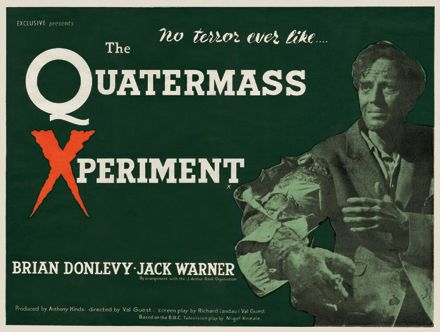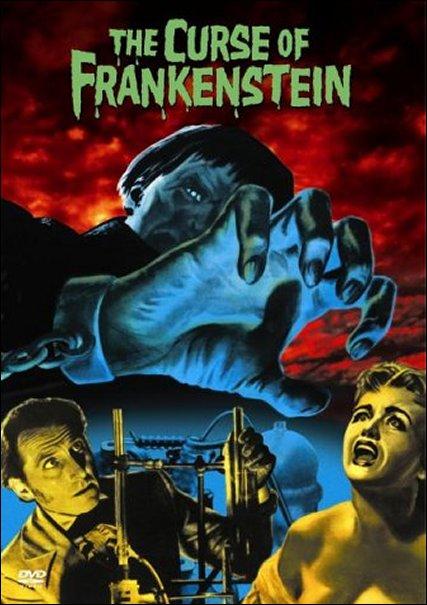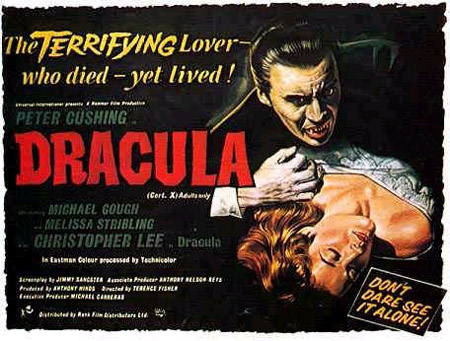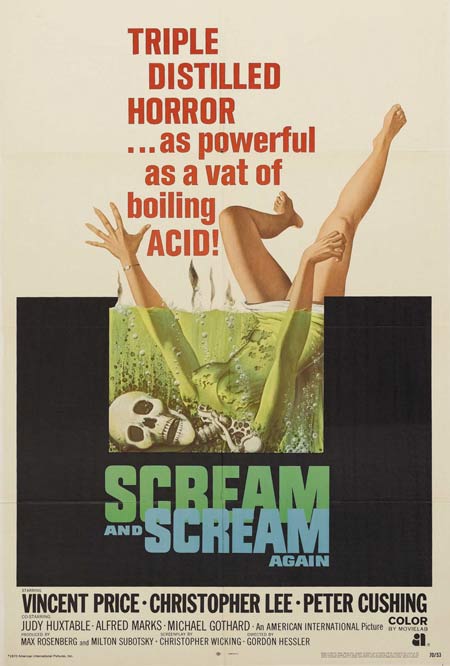English Gothic: Britain Goes to the Movies
 Jonathan Rigby’s ENGLISH GOTHIC (2000) is an excellent survey of British horror and science fiction films. Misleadingly subtitled A CENTURY OF HORROR CINEMA; the book focuses instead on the 20 year period from THE QUATERMASS XPERIMENT (1955) through TO THE DEVIL, A DAUGHTER (1976) when British production companies like Hammer, Amicus, and Tigon consistently outperformed the Hollywood majors in producing the finest and most influential genre films.
Jonathan Rigby’s ENGLISH GOTHIC (2000) is an excellent survey of British horror and science fiction films. Misleadingly subtitled A CENTURY OF HORROR CINEMA; the book focuses instead on the 20 year period from THE QUATERMASS XPERIMENT (1955) through TO THE DEVIL, A DAUGHTER (1976) when British production companies like Hammer, Amicus, and Tigon consistently outperformed the Hollywood majors in producing the finest and most influential genre films.
Part of the book’s strength is not just Rigby’s detailed and chronological survey of nearly every genre film to come from the British Isles during these two decades, but the fact that he captures the social and economic factors that helped shape the pictures and, more importantly, the public’s reception to them.
The rise of the horror genre in film started with the German Expressionist classics of the silent era and the contemporary Lon Chaney and John Barrymore efforts in the States. The genre solidified with the phenomenal impact of Universal’s horror franchises of the 1930s and 1940s.
The interesting thing here is that the majority of these films remained unscreened or else limited to adult-only audiences in the UK where censorship was extremely puritanical in the first half of the last century.
 The walls began to crumble in the mid-1950s when Britain made an unexpected advance in producing the most accomplished and mature genre films of the era. Hammer’s big screen adaptation of Nigel Kneale’s BBC serial, THE QUATERMASS EXPERIMENT in 1955 was the signal point for this revolution. The film version dropped the “e” from XPERIMENT to emphasize the film’s Certificate X from the BBFC as a veritable badge of honor.
The walls began to crumble in the mid-1950s when Britain made an unexpected advance in producing the most accomplished and mature genre films of the era. Hammer’s big screen adaptation of Nigel Kneale’s BBC serial, THE QUATERMASS EXPERIMENT in 1955 was the signal point for this revolution. The film version dropped the “e” from XPERIMENT to emphasize the film’s Certificate X from the BBFC as a veritable badge of honor.
Rigby makes an excellent point that the success of Nigel Kneale’s scripts for this and his subsequent QUATERMASS sequels lies in crafting the threat of alien infiltration (rather than the invasions that dominated nightmares across the Atlantic) in the fashion of horrific tales of demonic possession. This provides both an interesting comparison to and contrast with the Cold War atomic fears and that dominated genre films in the US and Japan during the same decade.
Hammer’s unexpected decision to move away from gritty monochromatic horror-tinged science fiction into opulent, full-color Gothic horror with THE CURSE OF FRANKENSTEIN (1957) cemented Hammer and Britain’s dominance of the genre for the next two decades.
 While the US was turning out drive-in exploitation fare aimed at teenage audiences or younger, Hammer found a goldmine in combining the stylish direction of Terence Fisher with the charisma and sophistication afforded by talent such as Peter Cushing and Christopher Lee.
While the US was turning out drive-in exploitation fare aimed at teenage audiences or younger, Hammer found a goldmine in combining the stylish direction of Terence Fisher with the charisma and sophistication afforded by talent such as Peter Cushing and Christopher Lee.
The trio quickly moved forward with Hammer remakes of DRACULA (1958) and THE MUMMY (1959). The studio borrowed not only titles from Universal’s horror stable of the past, but also followed their lead in churning out sequels to these revamped box office success stories beginning with Fisher’s THE REVENGE OF FRANKENSTEIN (1958) and THE BRIDES OF DRACULA (1960).
The dawning of the 1960s brought Hammer competition from fellow British production company Amicus with a series of literate horror anthologies; Tigon with increasingly mature fare culminating in Michael Reeves’ WITCHFINDER GENERAL (1967); and most importantly, the incursion from American International Pictures’ cycle of Edgar Allan Poe adaptations starring Vincent Price. There was no shortage of films in the sixties that not only rivaled Hammer in terms of quality, but also in popular appeal.
Sadly, the sixties marked the rapid decline of Hammer as the studio moved from producing quality pictures (such as Terence Fisher’s 1962 elegant remake of THE PHANTOM OF THE OPERA and Don Sharp’s chilling 1963 effort, KISS OF THE VAMPIRE) to cynically churning out product in rapid succession with inferior franchise sequels (such as Freddie Francis’ THE EVIL OF FRANKENSTEIN (1964) and several execrable MUMMY sequels).
 Hammer rallied late in the decade with a surprisingly strong return to form with Roy Ward Baker’s QUATERMASS AND THE PIT (1967) with Andrew Keir filling Brian Donlevy’s shoes as Professor Quatermass; Freddie Francis’ DRACULA HAS RISEN FROM THE GRAVE (1968) starring Christopher Lee; and Terence Fisher’s FRANKENSTEIN MUST BE DESTROYED (1969) starring Peter Cushing.
Hammer rallied late in the decade with a surprisingly strong return to form with Roy Ward Baker’s QUATERMASS AND THE PIT (1967) with Andrew Keir filling Brian Donlevy’s shoes as Professor Quatermass; Freddie Francis’ DRACULA HAS RISEN FROM THE GRAVE (1968) starring Christopher Lee; and Terence Fisher’s FRANKENSTEIN MUST BE DESTROYED (1969) starring Peter Cushing.
Not only were these stylish films with exemplary production design, cinematography, and acting, but Hammer tapped into the zeitgeist by offering thought-provoking films that grappled with many of the moral questions that marked the turbulent changeover to the 1970s. Amicus and AIP joined forces and produced disturbing fare such as Gordon Hessler’s SCREAM AND SCREAM AGAIN (1969).
 The Age of Aquarius spelt the rapid fall of Hammer. Like many empires before it, Hammer rotted from the inside as much as it failed to fortify its strength in defending its market share.
The Age of Aquarius spelt the rapid fall of Hammer. Like many empires before it, Hammer rotted from the inside as much as it failed to fortify its strength in defending its market share.
The ravages of time and an exodus of talent saw the studio opting to back a slate of pictures that were artistic suicide. Soft-core exploitation fare presenting lesbian vampires as little more than heterosexual eye-candy in Tudor Gates’ embarrassing trilogy based on Sheridan Le Fanu’s CARMILLA. Updating the Christopher Lee DRACULA films to a contemporary 1970s setting; thereby sacrificing quality and intelligence in exchange for mini-skirts and dated flower power rhetoric that was passé by 1972. Worst of all, awkwardly marrying Gothic horror with martial arts mayhem in a co-production with Shaw Brothers of Hong Kong called THE LEGEND OF THE SEVEN GOLDEN VAMPIRES (1974).
Hammer’s rivals fared better with Amicus still turning out quality horror anthologies as late as 1974. Sadly, Britain was unable to compete with Hollywood in the new decade. The low budget terrors of Amicus paled next to THE EXORCIST (1973) and by the time of STAR WARS (1977), anyone without American millions behind their film was doomed to ever-diminishing returns in a highly competitive marketplace.
To his credit, Rigby also covers the art films produced outside of the mainstream horror studios that helped transform the genre in the coming decades such as Roman Polanski’s REPULSION (1964) and MACBETH (1970). A lengthy final chapter considers late-period genre highlights from Britain (admittedly all works produced outside of the mainstream) such as Neil Jordan’s THE COMPANY OF WOLVES (1984), Ken Russell’s GOTHIC (1986) and THE LAIR OF THE WHITE WORM (1988), and Clive Barker’s HELLRAISER (1987).
ENGLISH GOTHIC is both a highly informative and highly opinionated walk through fifty years of British cinema. Rigby handily demonstrates how simple entertainments reflected their times and were influenced by (as much as they served to reinforce) the changing times in an era when Britain did much to shape the culture and politics of the Western world. Highly recommended.
William Patrick Maynard was authorized to continue Sax Rohmer’s Fu Manchu thrillers beginning with The Terror of Fu Manchu (2009; Black Coat Press). He is currently working on a sequel, The Destiny of Fu Manchu as well as The Occult Case Book of Sherlock Holmes. To see additional articles by William, visit his blog at SetiSays.blogspot.com